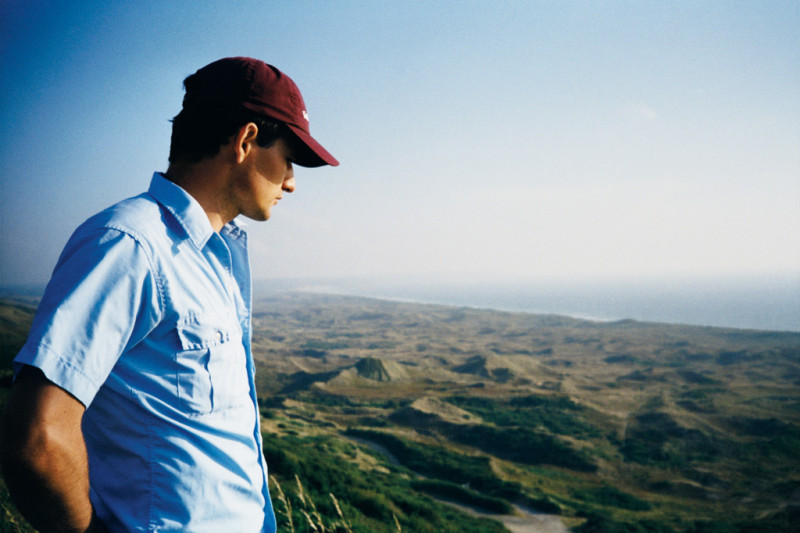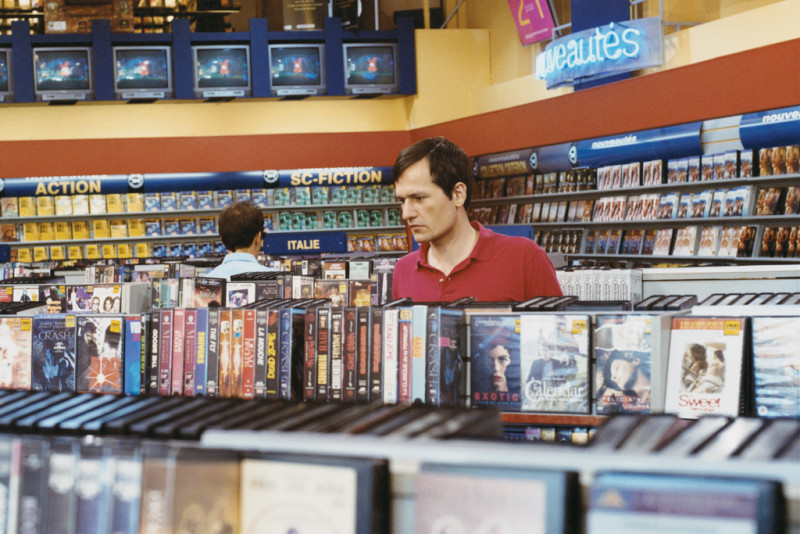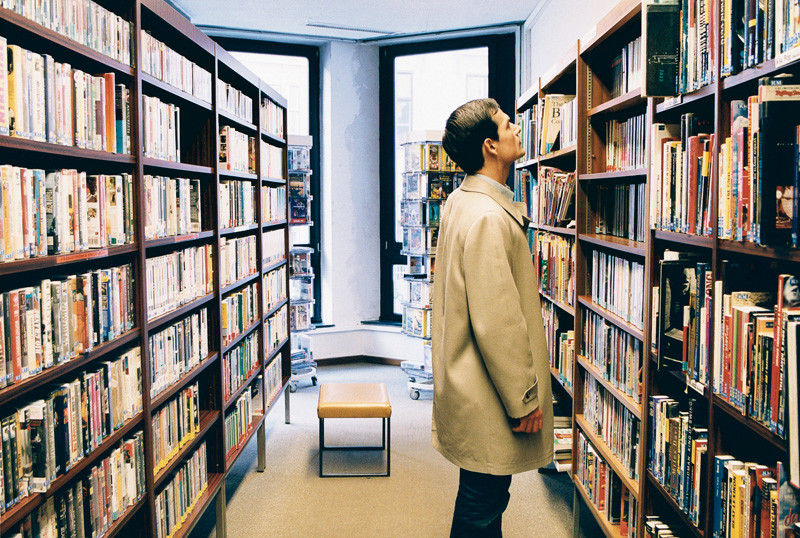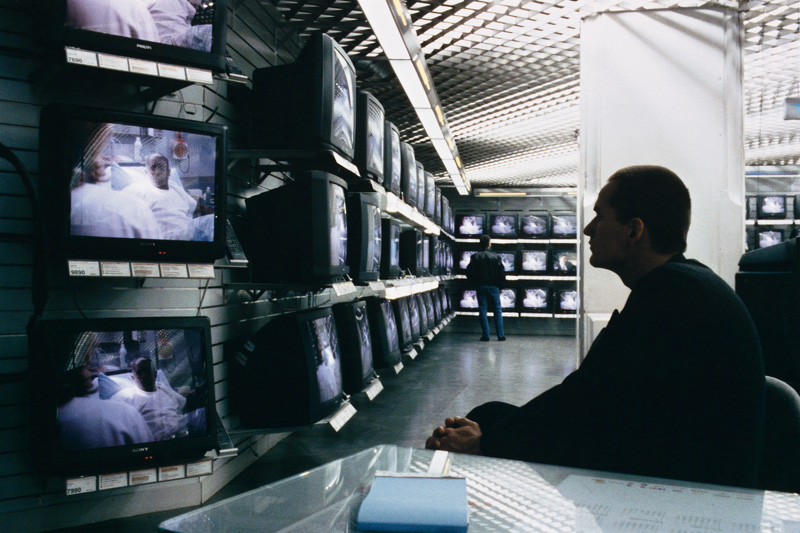[Fall 2004]
To take the title or the visual appearance as a starting point already implies taking part in a discourse that is subverted by the work itself. Many aspects suggest that the work is an ironic celebration of a kind of absence that can be completed only by the viewer’s imagination. What we see is an imbroglio of cultural texts that does not allow the viewer to escape to any secure ground despite the reflection on its conditions.
by Reinhard Braun
“The Artist at Work” – does this legend not still revolve around phantasms of the genius emotionally strained to the limit in his studio (for this legend is a male one), bent over his artwork (preferably a painting or a sculpture), doing battle with the overly extravagant imaginary, struggling for a form that will ultimately be the brilliant result of this reclusive, prototypically subjective process of creation?
We feel far removed from this cliché, and rightly so; but on the other hand, do we accept the relevance to artistic production when someone – posing as an artist, or someone involved in a context of production that may be summed up by the concept of art – is seen browsing in a video shop? Or studying the countless television sets on sale in a department store? We tend, rather, to associate a trip to the library with the production of art, which is regarded as an intellectual activity.
Under the working title The Artist at Work, has created a number of projects since 1993 (starting out in co-operation with Marylène Negro) that, from a photograph of the artist going about more or less everyday tasks, focuses on art as a paradoxical form of work, confronting it with its utopian aspect and its legend of ineffable subjective creativity. But bringing this legend – which has, above all, persisted as a caricature of itself and which can be perceived only as a strange undead entity – back into play does not revive any conservative, romantic dispositif of subjectivity to polemically turn against the world of art itself. On the other hand, focusing on this legend and presenting it in an ironic manner still concerns the conditions of contemporary art production, particularly as the series re-evokes – or, rather, re-connotes – a seemingly totally irrelevant artist figure. The very fact of not being able to escape these associations suggests that the work somehow inevitably refers to a kind of cultural knowledge, to an intransigent cultural text that permeates the images and perception, regardless of what discursivization this knowledge may already have achieved.
At Artspeak in Vancouver in February 2004, Scherübel presented the overhead projection of a photograph – a notable media constellation in itself – of himself in a sparsely populated movie theatre, before or after the screening of a film or during an intermission, but focusing on the screen in a strangely inappropriate way in view of the fact that, considering the light in the theatre, there is probably nothing to be seen. The gallery, on the other hand, presented a row of folding seats that put the audience in the same position, as it were, as the artist, looking at a significantly unspectacular picture, albeit in different settings of public presentations (movie theatre – gallery).
The Artist at Work series can doubtless be seen against the backdrop of conceptual strategies in the tradition of Marcel Duchamp and Andy Warhol, who celebrated the conversion of a life-style and thus of the artist’s privacy into a form of art – that is, who formulated this lifestyle as both the content and the form of the art: the chess game or the celebration of the Factory collective as life-as-art. But unlike this form of effusiveness captured in pictures (which itself is perhaps part of a legend), an aspect found throughout Scherübel’s image production is essentially nothing more than everyday banality (which cannot be said of a photo of Marcel Duchamp playing chess with a nude model). But who or what legitimizes the game of chess, the endless film shots of New York buildings, the threads arranged in lavish boxes, or the prosaic silkscreen print of a banknote as art products? Does Scherübel not embroil us in precisely the same spiral of argumentation when these photographs of everyday activities are interpreted as art products, because – and only because – this is indeed an artist at work, and not a librarian, a movie buff, or a video freak?
If Walter Benjamin has insisted that photography requires a text in order to convey its meaning and if, at the same time, as Roland Barthes impressively demonstrated, we almost automatically ascribe and inscribe an it-was-thus (in)to the images, we can certainly assume that Scherübel’s series is a simulation of a conflictual cultural context of description with and through images: the context of art itself. For on the one hand, it is only the title of the work that reveals the paradoxical content that is, in turn, both confirmed and perturbed by the facticity of the visual description. And does this description not fall straight into the trap of this simulation of a critical simulation because it nevertheless describes this production as art, as art about art? Or should we, rather, be interested in the banal fact that artists, too, explore landscapes, visit archaeological digs, watch films, or even read (a dig at star cult, an ironic comment on a search for identity)? So is there something like a pop-culture-imbued art object or a subject as art object in Scherübel’s works? Does the “actual” work consist ultimately not in photographic production but in the ironic, paradoxical performance of a quasi-postmodern lifestyle that implies the affirmation of consumerism and mass media? Ironic and paradoxical as this performance is, it is set on the borderline between consumerism and production and thus, at the same time, signals the different roles assumed by the artist in the course of production.
Or is it, rather, a matter of precisely this idea of the “actual” work as a blank space in the framework of all the contradictions inherent in culture and art, as something that Slavoj Zizek called a symptom that we would ultimately have to love, like ourselves, in order to endure the rift between the real and the symbolic? Would Scherübel’s “work” then not describe art as a kind of psychotic symptom of culture? The question ultimately remains of whether, in view of postmodern disillusionment, it is not totally inappropriate to ask this question in the first place, and whether Scherübel’s work focuses on precisely this inappropriateness, albeit taking it as a pretext to pose totally different questions: the question about the production conditions that could identify the artist as an artist and, linked to this, the question about the role of art in the sphere of current cultural processes as a whole.
Untitled (The Artist at Work) revises and reactivates the artist-subject as the foundation of modernism and translates the practice of art production into one that, above all, has to do with, and is embroiled in, everyday – but for this very reason fundamental – activities of cultural communication and the production of cultural knowledge. This would seem to be borne out by a second photo in the aforementioned overhead projection at Artspeak that was shown alternately; this picture shows the artist in a public library looking for a certain, though unspecified, book. This book may be seen as an interface or joint, as it were, to another work that is equally concerned with utopias of modernism, that therefore also focuses on and once again discusses the foundations of contemporary art production, which is why it would also appear to be relevant to a debate on the Artist at Work series: Mallarmé, The Book, or Mallarmé. Das Buch, presented in Graz, Vienna, New York, and, most recently, Vancouver, focuses on Stéphane Mallarmé’s failed “world book enterprise” that he conceived and documented in numerous letters, notes, and several writings “on the book” in the last thirty years of his life. Mallarmé defined The Book as a “boundless [publication] completely freed of its author and coincidence, containing the sum of all conceivable books.” Scherübel has now produced a dummy of Mallarmé. Das Buch that consists only of a cover, but that conforms to Mallarmé’s design in terms of size. So with this manifestation of the book as a conceptual artwork, Scherübel once again picks up on a modernist legend that, in both cases, features only through its absence and, particularly, engenders and furthers the discourses on its meanings only in this form of (partial or complete) absence, like the cryptic, encrypted notes and utterances of Marcel Duchamp (on the Large Glass or the Large Box). Compared to the Artist at Work project series, here again we have a work characterized by a fundamental aspect of absence (in this case the content of a book, in the other case an activity to be defined or productively designated). The question remains of how to make appropriate reference to this paradoxical work (that of Scherübel or Mallarmé?), which could assume the status of reality only through its absence, considering that the work in both cases consists above all of references that leave something behind in art that has to do with announcement, description, and the addressee’s expectations, with a system of documentation that both describes and constructs the work. Because, to take the text or the visual appearance as a starting point already means taking part in a discourse that is subverted by the work itself. We are therefore in the unsecured realm of assumptions and banalities; and yet, it would seem that the artists are no better off in this respect.
Born in Austria, Klaus Scherübel currently resides in Montreal. His conceptual practice – using media as diverse as photography, text, book and video – is based on a critical analysis of different systems of cultural production. His work was recently presented at Printed Matter Inc., New York, and Art Speak, Vancouver (2004); Fundazió Juan Miró, Barcelona, Landesgalerie am Oberösterreichischen Landesmuseum, Linz, and Frac Languedoc-Roussillon, Montpellier (2003); L’Espace VOX, Montréal (2002); and Neue Galerie am Landesmuseum Joanneum, Graz (2001).
Born in 1964, Reinhard Braun is an independent author and curator, living and working in Graz, Austria. Since 1990, he has produced numerous exhibition projects, publications, lectures, and studies on the history and theory of photography and media. He has also co-operated with artists on projects in the field of media. In 1999, he co-founded the association MiDiHy, which has launched several projects on the cultural impact of media technology. Since 2003, he has been curator for Camera Austria.
(http://braun.mur.at; http://midihy.org; http://www.camera-austria.at)





